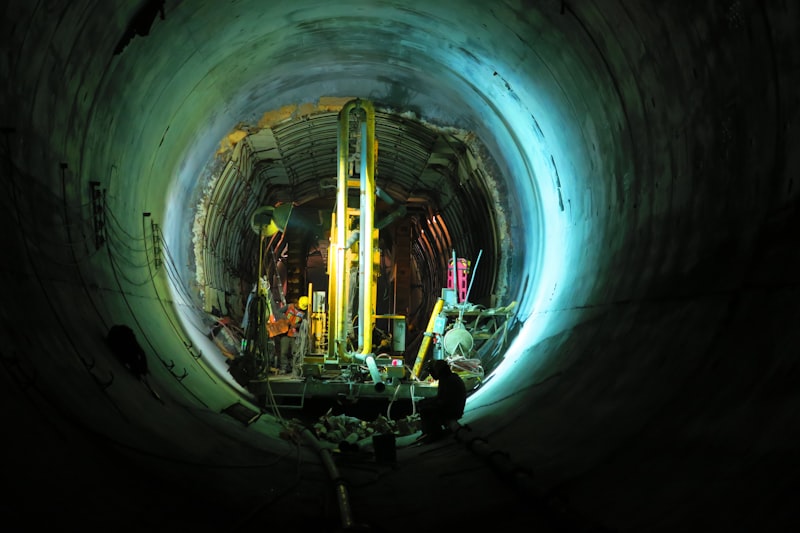Imagine a construction site where drones zip through the air, conducting surveys and inspections with pinpoint accuracy. These unmanned aerial vehicles (UAVs) can capture real-time data and high-resolution images, allowing project managers to monitor progress and detect potential issues before they escalate. It’s like having a team of high-tech inspectors working around the clock, ensuring every detail is perfect.
Robots have also found their place in this dynamic landscape. From bricklaying robots that can build walls in record time to exoskeletons that support workers and reduce physical strain, these machines are augmenting human capabilities and improving safety on site. They’re not replacing jobs—they’re enhancing them, allowing skilled workers to focus on more complex tasks while robots handle the heavy lifting.
But it’s not just on the construction site where technology is making waves. Building Information Modeling (BIM) has revolutionized the way projects are designed and managed. By creating digital representations of physical and functional characteristics of a facility, BIM enables architects, engineers, and construction professionals to collaborate more effectively, visualize the end product, and identify potential challenges early in the process. It’s like creating a virtual prototype of a building before the first brick is even laid.
And let’s not forget about sustainability. Green building practices and materials are becoming increasingly important, driven by both regulatory requirements and consumer demand. Technology is enabling construction companies to adopt eco-friendly solutions, such as using recycled materials, implementing energy-efficient systems, and designing buildings that produce their own renewable energy.
Building the Future: Innovations Reshaping Construction Technology
One of the most exciting innovations is 3D printing. Imagine a printer that can build entire houses layer by layer, using concrete or even recycled materials. This technology not only speeds up construction but also reduces costs and waste. It’s like watching a building rise out of thin air, powered by digital designs and precision engineering.
Another game-changer is the Internet of Things (IoT). In construction, IoT means connecting equipment, vehicles, and even workers through sensors and data networks. This connectivity allows for real-time monitoring of projects, predictive maintenance of machinery, and improved safety on site. It’s akin to having a construction site that can think and react to its environment.
Robotics is another area where innovation is transforming the industry. Robots are now capable of tasks once reserved for skilled craftsmen, from bricklaying to welding. These robots work tirelessly, with precision that surpasses human capabilities, creating structures that are not only faster to build but also more durable and exact.
Virtual reality (VR) and augmented reality (AR) are revolutionizing how projects are designed and managed. Architects and engineers can now step into their designs, visualize every detail, and detect potential issues before construction even begins. It’s like having a superpower to see through walls and under foundations, ensuring every aspect is perfect.
Lastly, sustainable construction practices are becoming paramount. With eco-friendly materials and energy-efficient designs, buildings are not just structures but statements of environmental responsibility. It’s about constructing a future where our homes and offices leave a minimal footprint on the planet.
From Blueprints to Byteprints: The Digital Revolution in Construction

Imagine a world where towering skyscrapers and intricate structures are meticulously planned and executed with precision, all thanks to the digital revolution in construction. Gone are the days of traditional blueprints on paper; enter the era of digital “byteprints” that are reshaping the landscape of the construction industry.

In essence, byteprints are the digital counterparts of traditional blueprints. They encapsulate every detail of a construction project in a virtual format, allowing architects, engineers, and builders to collaborate seamlessly across vast distances and intricate designs. What once required bulky rolls of paper now fits neatly into digital files that can be accessed at the touch of a screen, transforming the way projects are conceptualized and executed.
The impact of this shift is nothing short of revolutionary. Picture architects using advanced software to create 3D models that simulate real-world conditions, enabling them to identify potential challenges and refine designs before breaking ground. Engineers leverage sophisticated algorithms to optimize structural integrity and energy efficiency, pushing the boundaries of what is possible in modern construction.
But it’s not just about efficiency; it’s about sustainability too. Digital technologies allow for better resource management, reducing waste and environmental impact. By fine-tuning every aspect of a project digitally, from material selection to construction schedules, builders can minimize their carbon footprint while maximizing the longevity and resilience of their creations.
Moreover, the digital revolution fosters innovation at every level. Contractors armed with tablets oversee worksites in real-time, ensuring that every beam is placed with utmost accuracy. Drones soar overhead, surveying progress and inspecting hard-to-reach areas, enhancing safety and speed. Even project financing and client communications benefit from digital transparency and real-time updates, fostering trust and accountability.
Smart Tools and Smarter Buildings: Technology’s Impact on Construction
Imagine walking onto a construction site where workers aren’t just wielding hammers and measuring tapes, but also equipped with state-of-the-art smart tools that enhance efficiency and precision. These tools, ranging from laser measuring devices to advanced drones, have revolutionized the way tasks are executed. They not only save time but also minimize errors, ensuring that every cut is precise and every angle is perfect.
But it’s not just about the tools themselves; it’s about how they’re integrated into the construction process. Take Building Information Modeling (BIM), for instance. It’s like creating a digital twin of a building before it even exists in the physical world. Architects, engineers, and contractors can collaborate seamlessly, foresee potential challenges, and optimize designs—all before breaking ground. This not only reduces costs but also speeds up construction timelines, delighting clients and stakeholders alike.
Moreover, technology has empowered buildings themselves to be smarter. Imagine a building that adjusts its temperature based on occupancy patterns or optimizes energy usage in real-time. These smart buildings aren’t just futuristic concepts anymore—they’re becoming the norm. They improve sustainability, enhance occupant comfort, and even contribute to the overall health and well-being of its inhabitants.
In essence, technology’s impact on construction goes beyond mere efficiency gains. It’s about transforming an entire industry, making it more sustainable, cost-effective, and innovative. As we continue to embrace these advancements, one thing is clear: the future of construction is smart, and it’s already here.
Robots on Site: Automation’s Role in Modern Construction Projects
Picture this: a construction site buzzing with activity, but instead of just humans in hard hats, there are robots deftly maneuvering heavy materials, laying bricks with pinpoint accuracy, and even scaling heights for inspections. These robots aren’t just sci-fi dreams anymore; they are the backbone of efficiency in construction.
One of the key areas where robots excel is in repetitive tasks. Think about the monotonous but essential jobs like bricklaying or pouring concrete. These tasks, when done manually, not only take time but also increase the margin for error. Robots, on the other hand, can do these tasks tirelessly, with the same precision every single time. This not only speeds up the construction process but also ensures a higher level of quality and consistency.
But it’s not just about doing the same thing over and over. Robots are also making strides in complex tasks that require intricate movements and calculations. For instance, some robots are equipped with advanced sensors and AI algorithms that allow them to navigate through construction sites autonomously, avoiding obstacles and adjusting their actions in real-time based on changing conditions.
Moreover, robots are enhancing safety on construction sites. Construction is inherently risky, with hazards ranging from heavy machinery accidents to falls from heights. By delegating dangerous tasks to robots, human workers can focus on more strategic and less hazardous aspects of the project, thereby reducing the overall risk of accidents and injuries.
Wearable Tech and Safety: Enhancing Construction Site Security
Imagine a construction worker equipped with a smart helmet that not only protects their head but also monitors vital signs in real-time. This isn’t just futuristic speculation; it’s the reality of wearable technology in construction safety today. These smart helmets are equipped with sensors that can detect hazardous environmental conditions such as high levels of toxic gases or sudden changes in temperature. They alert the wearer and supervisors instantly, allowing for swift action to mitigate risks.
Moreover, wearable devices like smart vests are revolutionizing how construction site managers track their workforce. These vests come embedded with GPS trackers and motion sensors, enabling supervisors to monitor the exact location and movement of workers in real-time. This not only enhances safety by ensuring workers stay within safe zones but also improves overall efficiency by optimizing workflow management.
But it doesn’t stop there. Wearable tech is also being used to monitor physical strain on workers. Smart clothing embedded with biometric sensors can track heart rate, fatigue levels, and even posture. This data is invaluable in preventing overexertion injuries and ensuring workers take necessary breaks before exhaustion sets in.
The impact of wearable tech on construction site security goes beyond just physical safety. It extends to cybersecurity as well. With the integration of IoT (Internet of Things) devices in construction machinery and equipment, ensuring these devices are secure from cyber threats is crucial. Wearable tech can play a pivotal role in this aspect by providing secure authentication and encrypted communication channels.
Virtual Reality Meets Real-world Construction: A New Era Begins
In the realm of real-world construction, VR is not just a tool but a game-changer. It allows architects, engineers, and developers to collaborate in unprecedented ways, walking through virtual structures, tweaking designs on the fly, and spotting potential issues long before construction crews arrive onsite. This means fewer surprises during the building process and ultimately, cost savings for developers and clients alike.
One of the most striking aspects of VR in construction is its ability to bridge the gap between design and reality. In the past, blueprints and 3D models served as the primary means of visualizing a project. However, VR takes this a step further by immersing stakeholders in a lifelike experience where they can explore every nook and cranny of a building before it’s built. This not only enhances understanding but also fosters better decision-making throughout the project lifecycle.
Moreover, VR isn’t just for design review. It’s also a powerful tool for training and safety. Imagine training construction workers in a virtual environment where they can practice complex tasks without any real-world risks. This not only improves skills but also reduces accidents onsite, making construction sites safer for everyone involved.
As VR technology continues to evolve, so too will its applications in construction. From improving project timelines to enhancing communication among teams, VR is set to redefine how we build the cities and structures of tomorrow. It’s not just about seeing a building in 3D; it’s about experiencing it in a way that was once unimaginable.
Drones Above, Efficiency Below: Aerial Technology in Construction
In the ever-evolving world of construction, technological advancements are reshaping how projects are planned, executed, and completed. One such innovation taking the industry by storm is the use of drones. These unmanned aerial vehicles aren’t just a novelty; they’re revolutionizing the efficiency and precision of construction processes from the skies down to the ground.
Imagine this: a construction site buzzing with activity, and high above, a drone hovers gracefully like a vigilant sentinel. Its keen eye captures detailed images and videos, providing a panoramic view that was once only possible from costly helicopters or labor-intensive manual surveys. This aerial perspective isn’t just for show—it’s a game-changer. Project managers and engineers can now monitor progress, inspect hard-to-reach areas, and identify potential issues with unprecedented clarity and speed.
But drones aren’t limited to mere observation. Equipped with advanced sensors and cameras, they gather data that fuels cutting-edge analytics and modeling software. These insights empower decision-makers to make informed choices swiftly, optimizing workflows and resource allocation. From surveying land before breaking ground to monitoring construction quality throughout the build, drones ensure every phase operates at peak efficiency.
Moreover, the efficiency gains extend beyond surveillance and data collection. Consider the logistics of large-scale projects: materials need to be delivered promptly, and site conditions must be constantly assessed for safety and productivity. Drones can deliver supplies to remote or hazardous areas swiftly and accurately, reducing downtime and enhancing worker safety. In emergencies, they can swiftly assess damage or danger zones, aiding in swift responses that save both time and money.
In essence, drones aren’t just about high-tech gadgets in the sky; they’re catalysts for efficiency, safety, and cost-effectiveness in modern construction. They streamline operations, enhance project oversight, and empower teams to achieve more with less. As the construction industry continues to embrace innovation, drones are poised to remain at the forefront, reshaping how we build the world around us.
Frequently Asked Questions
How does automation impact construction site safety
Learn how automation affects construction site safety, exploring its role in reducing human error, enhancing precision in tasks, and improving overall efficiency. Discover how automated technologies mitigate risks, promote compliance with safety protocols, and contribute to a safer working environment.
What are the benefits of using drones and AI in construction management
Discover the advantages of integrating drones and AI in construction management. Enhance project efficiency with real-time aerial surveys, precise site mapping, and automated progress monitoring. Reduce costs through improved resource allocation and accurate data-driven decision-making.
What are the key technologies transforming construction today
Discover the key technologies shaping the future of construction, including advanced materials, robotics, 3D printing, and AI. Learn how these innovations improve efficiency, sustainability, and safety in modern construction projects.
How is digitalization improving efficiency in construction projects
Learn how digitalization enhances efficiency in construction projects through streamlined communication, real-time project tracking, automated workflows, and data-driven decision-making.
What role does Building Information Modeling (BIM) play in modern construction
Building Information Modeling (BIM) revolutionizes modern construction by digitally managing building design, construction, and operation. It enhances collaboration, reduces errors, optimizes scheduling, and improves cost efficiency through virtual 3D models.


